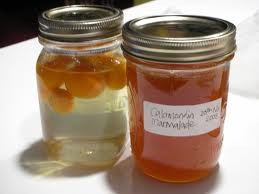Origin:
Calamondin grows in Northern India thanks
to its ability to thrive in colder climates. Some varieties, however, grow well
in sunny warmer regions.
Availability
of Calamondin in India:
Calamondin is a year-round crop, though
it’s not easily found on the shelves of Indian fruit stands and grocery
markets.
Where
to Find Calamondin in India:
Calamondin is one of those fruits that will
be sold on roadside stands outside of the farms producing them for commercial
ventures. Most crops are grown for food and drink manufacturers. If you know of
large fruit bazaars where restaurant owners or smaller vendors select and sell
their pickings, you might find calamondins. They might also trickle into the
stall of a few fruit sellers, but this fruit is not well known or used amongst
urban swaths of the population.
Some people have calamondin trees in their
yards for ornamental purposes.
Checking
for Ripeness in Calamondins:
Calamondins, like most citrus, start out as
hard and green. When ripe, they turn orange and can be mistaken for tangerines.
Taste
of Calamondin:
An Oliodigest digest article describes the
taste of a calamondin as follows: bitter if picked too soon, sour when nearing
ripeness, and at its peak, it’s still sour. At best, one bite of a calamondin
makes other fruits taste sweeter. Its pulp is also highly acidic.
Nutritional
Value of Calamondin:
As per an article by the University of
Florida, a single calamondin fruit provides the following nutrients:
12 kcal
negligible fat
1.1 g of Fiber (4.8% RDI)
37mg of Potassium (1.2% RDI)
7.3mg of Vitamin C(12.1% RDI)
57.4 iu of Vitamin A (1.1% RDI)
8.4 mg of Calcium (less than 1% RDI)
3.1g of Carbs
Health Benefits of Calamondin:
Calamondin health benefits might not be
readily apparent, but its oils, juice, and extracts have many uses. The Olio
Digest article outlines the following medicinal benefits:
-Its juice, when applied to the scalp,
reduces itching and promotes hair growth.
-Rubbing a cut calamondin on bug bites
reduces itching and irritation
-Its juice clears the skin and itching in
the vulva
-Combined with pepper, the calamondin
reduces phlegm
-Its juice is also a laxative
How
to Open/Cut:
Calamondin can be cut or peeled, just like
many varieties of oranges and tangerines. This fruit has plenty of seeds,
though.
Calamondin
Recipe Ideas:
You can use calamondines as you would for
either oranges (provided you add a ton of sweetener) or lemons and limes. In
fact, the Florida population used to use calamondins as lemon substitutes until
the latter came into greater production. Next time a recipe calls for lime,
lemon or orange, think about using a calamondin instead!
This means that calamondins can be used for
all of the following recipes:
-Sweet
breads (like lemon bread, or lemon poppy seed
muffins)
-Marmalades
and other jams
-Dips (like a calamondin/soy sauce dip)
-Glazes
(lemon glaze)
-Pies
(like a key lime pie, but instead a beautiful lemony calamondin tart)
-Juice:
Freeze them into ice cubes and add to a pitcher of water for
“calamondinade” (tip taken from the University of Florida)
-Sparkling
soda
-Squeezed over stir fries to create a zesty citrus flavor
Personal
Experience:
I’ve eaten “ornamental” oranges on many
occasions—while not quite the same as a calamondin, I’m vey familiar with that
sour citrusy flavor deriving from decorative oranges. My home town has what I
deemed as “fake” orange trees everywhere, including my old college campus. I’ve
not seen calamondins in India quite yet.
Sources:
http://sarasota.ifas.ufl.edu/fcs/FlaFoodFare/Calamondin.pdf
Best article on calamondin I’ve come
across:












No comments:
Post a Comment